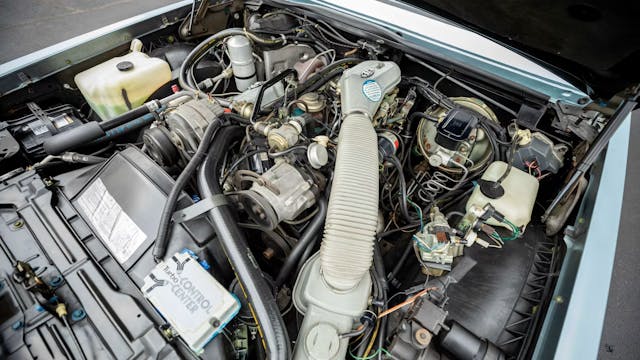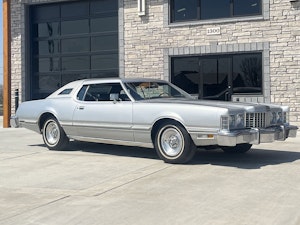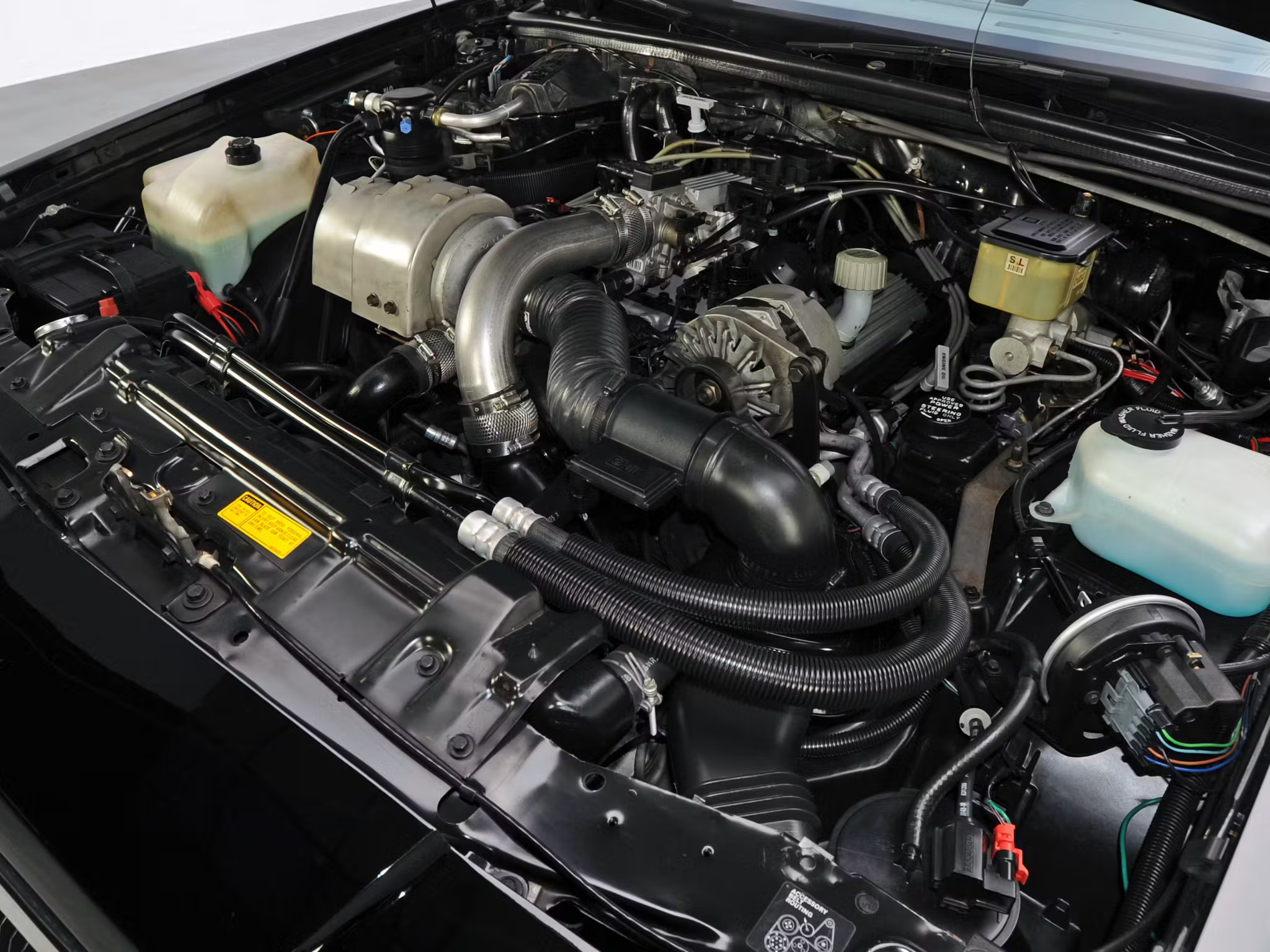Media | Articles
GM’s 3800 V-6 was long-lived and underappreciated
The Chevy small-block V-8 is perhaps the most famous engine ever produced by General Motors. It is a simple, stalwart design whose popularity and status only cemented as it became the powerplant of choice among hot-rodders. For more than 50 years, the small-block has been the backbone of affordable speed. However, just as significant in GM history is an engine that toiled (albeit less prominently) for nearly as long: the 3800 V-6.
Between its 1975 debut and its 2008 sunset, this 3.8-liter V-6 was installed under the hood of more than 25 million vehicles. Originally designed by Buick, it was mostly assigned to workhorse duty for Oldsmobile, Pontiac, and Buick, motivating fleets of sensible sedans and coupes. While the 3800 did enjoy a few flashes of auto enthusiast attention, it never got the same widespread adulation as the small-block or even the big-block, and many assign it second-tier status among engines in GM’s historic portfolio.
Here’s the story of how a derivative, near-castoff engine design came to be critical in fueling the fortunes of America’s largest car company.
Aluminum bad, iron good (but rough)
The 3800’s origins date back to the early 1960s, when Buick debuted the first V-6 passenger car engine ever to be manufactured in the United States. A byproduct of the company’s quest to produce its own unique, aluminum-block V-8 (marketed as the Fireball), the cast-iron V-6 Fireball was far easier and significantly cheaper to build. This being a mass-market powerplant, it also helped that the V-6 version did not suffer the high rate of defects associated with the V-8’s aluminum construction.
Unfortunately, despite the benefits of its relatively light weight, the Fireball V-6 retained several design elements from the V-8 that, initially, proved sub-par in translation. As a cost-cutting measure, GM effectively sliced a pair of cylinders from the end of the original engine while retaining the 90-degree bank angle. Though the V-8 enjoyed the balance of an even firing interval, the V-6 version had an odd firing interval that gave these early 3.2-liters a rough, rumbly idle.
Marketplace
Buy and sell classics with confidence

Even with softer, flexible motor mounts to absorb vibrations, it won few fans. The V-6 floated through the small and “intermediate” Buick and Oldsmobile line-ups between 1962 and 1967, and even a displacement boost couldn’t convince GM execs to stay the course.
Instead of reengineering the V-6 at great cost, perhaps with a balance shaft, Buick made a shrewder move: it offloaded the Fireball V-6 tooling to Kaiser-Jeep, which had no qualms about stuffing a less-than-smooth motivator into its Jeeps and other rustic SUVs. Fortunately, a third-act mea culpa forced by the OPEC energy crisis saw GM buy back the rights to its own engine design from a cash-starved AMC in 1974, after realizing its fuel-efficient cupboards had run largely bare.
It’s here that the 3800 series found its true beginning.
Will the real V-6 please stand up?

Always cost-conscious, GM had first tried to sweet-talk AMC into handling manufacturing the overhead-valve V-6 engine. After being rebuffed (or repulsed by a desperate American Motors quoting an exceptionally high price tag for production, depending on which story you believe), GM changed tack. It took a quick and easy route to push the V-6 to the market for 1975, punching displacement out to its final 3.8-liter form—in its own factory—but leaving everything else about the motor unchanged.
The 3.8-liter V-6 saturated GM showrooms almost immediately, powering models as diverse as the Chevrolet El Camino, the Pontiac LeMans, and the Buick Skyhawk, with stops in the Oldsmobile Cutlass and the Pontiac Firebird along the way. With close to 20 different models laying claim to the V-6, economies of scale were such that Buick’s once-cast-off engine finally warranted the refinement and development it had previously been denied a decade before. This primarily took the form of a split-pin crankshaft that revised the engine with an even-firing pattern, effectively erasing the previous, unpleasant vibrations.
This one simple decision, arriving in 1977, helped cement the engine as the bedrock of the General Motors passenger car. However, despite its status as an affordable powerplant (true for both manufacturers and buyers), the V-6 was about to pull a power move seldom seen in the automotive world: The humble 3.8 made a play for enthusiasts’ hearts with a red-hot high-performance edition.
Soaring fuel prices and crushing emissions regulations, you may recall, had sidelined large-displacement V-8 engines for much of the 1970s. That caused automakers far and wide to search for alternatives to big cubic inches. Buick had been toying with turbocharging for several years prior to the 1978 launch of its T-Type family, and boosted versions of the V-6 ultimately covered almost every two-door car built by the brand. The setup even branched out into motivating the Pontiac Trans Am Turbo and Chevrolet Monte Carlo Turbo. Forced induction proved an unexpected edge for GM as it moved into the ’80s, culminating in the era-defining Regal Grand National and GNX models. These legendary eight-cylinder-slayers owe their success to the might of GM’s turbo 3.8-liter V-6 engines.
Front-wheel drive future

While the rear-drive Grand National and its longitudinal engine may have garnered the most headlines, it was the transverse version of the 3.8-liter V-6 that had the broadest influence in the industry. General Motors was knee-deep in its transition to front-wheel drive platforms by the middle of the 1980s, and it massaged and modified the 3.8 to meet this new challenge. In the space of a few short years, the engine abandoned carburetors for electronic fuel injection, lost its traditional ignition distributor, and gained a balance shaft—moves that thoroughly modernized the V-6 to match the expectations generated by the rising tide of competing Japanese imports.
By 1988, the 3800 moniker became official. It was applied to a fresh crop of 3.8-liter engines that embodied the sweeping updates making so-equipped GM cars competitive with Ford, Toyota, and Honda. Dubbed the “Series I,” the engine was initially assigned to the mid-size and full-size sedans and coupes first to heed GM’s front-wheel drive call. It wasn’t long, though, before the transverse 3800 had spread into nearly every corner of the Buick, Chevrolet, Pontiac, and Oldsmobile empire.
Once again the bread and butter of General Motors’ engine strategy, the 3800 was once again courting forced induction at the start of the 1990s. This time it was a supercharger (rather than a turbo) stuffing additional atmospheres into the combustion chamber, and a blower first found its way into big-boned Buicks via the Park Avenue and its Oldsmobile and Pontiac equivalents.
Stay of execution

One more major metamorphosis awaited the 3800, this one nearly 35 years after its initial Fireball debut. Dubbed the “Series II,” this V-6 variation represented the culmination of GM’s engine design prowess at the time. It arrived in 1995 with cross-bolt main bearing caps, bigger valves nestled inside larger cylinder heads, the highest compression ratio to date, and a composite intake manifold, among many other internal and external improvements (including a lower deck height that helped with packaging and reduced weight). Also along for the ride was an improved, Eaton-supercharged edition of the engine that became nearly as common as the naturally aspirated version. The 3800’s dominance of General Motors drivetrains was nearly impossible to escape in any sedan or coupe car larger than compact-size.

The 3.8-liter V-6 was well-positioned to ride out the rest of the decade in style. While it received a Series III update for 2004 (including throttle-by-wire and a new fuel injection system, along with an aluminum intake manifold to replace the previous plastic unit), the fundamentals remained the same until it was pulled from production in 2008. By that point, the 3800 had far outlived its planned obsolescence, arguably by almost a decade—proof of what its diehard reliability and appealing low cost meant to GM’s bottom line.
An ode to endurance
Time has caught up to nearly every pushrod engine. While the LS-series of small-block Chevrolet V-8s continues to generate massive profits in the pickup and SUV market, General Motors eventually yielded to the efficiency benefits and sophistication of dual overhead camshafts in its passenger cars. The relatively large displacement of the 3800 in this context—slightly greater than the company’s current range-topping 3.6-liter V-6—didn’t make it an appealing do-it-all base engine in a world where turbocharged four-cylinders dominate.
Still, the endurance and relevance of the 3800 is astounding. Even at the end of its lifespan, in terms of weight the iron-block engine was within spitting distance of the aluminum block V-6 that replaced it, and its horsepower, torque, emissions, and fuel efficiency remained competitive until its final hour. What began as a decidedly simple, budget-driven afterthought evolved over several decades into a decidedly unsexy yet remarkably effective multi-purpose tool. It plugged nearly every hole in the GM line-up for decades. Following initial bumps, GM committed to continual improvement and modernization that extracted an absurd tour of duty from an engine that was, at the outset, dumped on a rival’s doorstep.
***
Check out the Hagerty Media homepage so you don’t miss a single story, or better yet, bookmark it. To get our best stories delivered right to your inbox, subscribe to our newsletters.














Great engine. Benjamín, correct me if I am wrong, but didn’t GM win awards for the 3800?
Mom had a 91 Olds 88 with this engine and it was fantastic. The 2002 Buick Regal GS Supercharged 3800 had 240 hp and was a very desirable car. My Buick now has an OHC 2.0 L Turbo with 228 hp, but similar fuel economy… technology (kind of) marches on!
We inserted a ’91 Buick Regal sedan from my wife’s uncle. Great car but it would arbitrarily shut down at random times. Replaced the ECU and the entire engine wiring harness twice before it was finally trailered to a local wrecking yard and was turned into a cube. The ’86 Grand National that we used to service was fun, but my son’s stock ’95 Z28 would smoke it in a quarter mile.
We inherited a ’91 Buick Regal sedan from my wife’s uncle. Great car but it would arbitrarily shut down at random times. Replaced the ECU and the entire engine wiring harness twice before it was finally trailered to a local wrecking yard and was turned into a cube. The ’86 Grand National that we used to service was fun, but my son’s stock ’95 Z28 would smoke it in a quarter mile.
Rob – you are right, Wards Auto gave it 3 ‘best engine of the year’ list placements in the 90s, and I believe it placed on their 10 best engines of the century list, too.
The 3.8 in turbo or supercharged guise was the most fun and memorable to me.
They also make insane performance happen when used as the motivation in Brunton Stalkers and Super Stalkers…
I had two Buicks with this motor in them, a 1986 Century Estate Wagon and a 1993 Regal Gran Sport. Fantastic! Great performance and good gas mileage. The wagon went on to some good friends at 115k and they drove it another 60k before an accident ended that car’s life. I traded the Regal after three years in an economy move to a Saturn SL2 twin cam (another story). The 3.8 (3800) V6 proved to be a great motor for me in both Buicks with almost 150k in total mileage between the two of them.
Bought a 1996 Pontiac Bonneville with 25k sold it at 200k car was still running when it was totaled in a wreck with over 250k, great fuel mileage and power , I would say one of the best engines GM built, even bought my son a Grand Prix 3800 supercharged, I was really sad to see it discontinued!
3800 in Australian holden Commodore’s since 1988 to 2003. Rear wheel drive.
Mom had a ’83 Bonneville wagon with one. Gutless turd AND the computer controlled carb. was an absolute gem>>it decided to floor itself once at a stop. Fortunately with no power, it couldn’t overcome the brakes to do any damage. Engine overheated with no warning on a trip and stuck tight as we coasted off to the side. Cooled off enough to turn over and restart. Changed the radiator at a service station just off the next exit. Burned a lot of oil after and had low oil pressure. Pulled it and replaced with SB Chevy. 3800 series much improved. Early ones were total junk.
Totally agree! I used to work at a service station in the 90’s and there was still quite a few 231 powered rear wheel drive GM vehicles around. Most of them were garbage. Oil pump issues, electronic feedback carburetors that were one step above Ford’s VV catastrophe. I never liked how they ran. Underpowered, especially when in a full sized car with highway gears. Then, the FWD version with the balance shaft became an entirely different animal. Good efi and ignition, great efficiency and power. Longevity was also superb. GM did a great job with the 3800 and in stock form, probably one the best engines GM ever made.
I Have a 2002 Buick LeSabre Limited with this engine. I bought it 12 years ago from a friend of mine that as a dealership in North Carolina. It had about 80K at that time & has about 110K on it now. I live in central New York state so winters here are brutal to a car. It was rust free, top to bottom.
I have only had to do normal maintenance since I’ve owned it, what a great car!!! ( the best $4,000 car I have ever had)
I have a 3800SC Series II in a 1986 Fiero GT five speed. In stock form, which it is not, it doubles the factory HP of the 2.8 V6 that was originally in all Fiero GTs. Not too much work (cold air intake, aftermarket exhaust manifolds, higher ratio rockers and underdrive supercharger pulley) probably has it closer to 280 HP. It will surprize many unsuspecting sport cars out there.
Bought a 1998 Chevy Monte Carlo Z34 with the 200 horsepower 3800 Series II engine back in ’03. Still have it today. Best trouble free car I’ve ever owned.
I’ve driven last gen Bonnevilles for the past 23 years (on my 3rd one). Other than a cracked plastic intake on the first one (fixed under warranty in the early 2000s) never had a problem with the engines. And, other than pulling the rear spark plugs, very easy to service. Went to 240,000 mi on my first one, then the next one to 180,000 mi (got rid of it because it was cosmetically very abused and the radio and A/C stopped working), and am at 185,000 on the current one. I’ve put 60,000 commuting miles on the present one in the past 3.5 years and it still runs great.
Had a 1990 Buick Century with a 3.3 V-6. I guess they downsized to boost fuel economy.
Seemed that the 3.3 was used in many G.M. cars. Surprised it wasn’t mentioned in the article.
Correct, it was a downsized version of the 3800. Also a great engine. My sister had one in a 92 Skylark. Only good part of the car.
Great motor. My mom had one in her 85 Regal, and I had one in my 87 Grand National and 2000 Grand Prix GTP. All ran great.
Owned a Pontiac Bonneville and a Buick Regal GS, both with fuel injected 3.8’s. Loved them both and would like to have one more of each!
Bought a 1998 Pontiac bonneville SSEI with 114k, 15 years later it has 205k and still going. Only problem was a cracked radiator and an alternator. No engine problems ever. Found out at 180k that I should change the oil in the supercharger. Every option, sunroof, heads up display, 9 way power leather seats, power everything…and all for $400